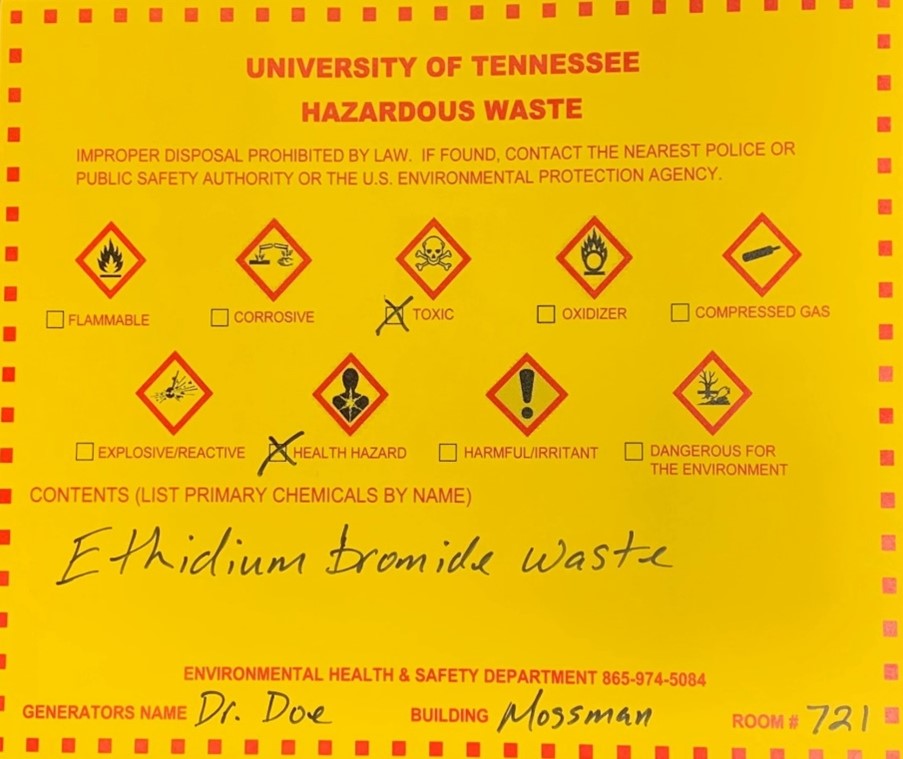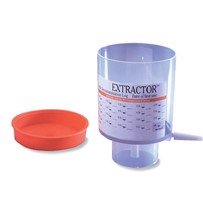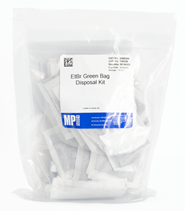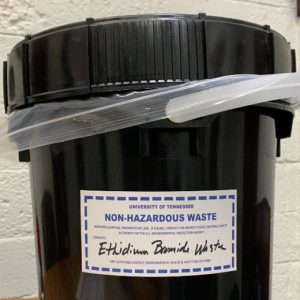UTK Environmental Health & Safety Guide LS-024
This guide provides safety considerations and procedural steps for the prudent management of ethidium bromide wastes
Effective Date: 09/14/2021
Revision Date: 09/14/2021
Purpose
Ethidium bromide is a chemical compound commonly used as a fluorescent tag (stain) for detecting nucleic acids. It is used in many molecular biology laboratories for techniques such as agarose gel electrophoresis. Ethidium bromide is moderately toxic at high concentrations and may be mutagenic. While disposal of ethidium bromide is not regulated by the Environmental Protection Agency (EPA), best practices indicate that it should be collected as a special waste and not poured down the drain or discarded as routine trash. This guide provides safety considerations and procedural steps for the prudent management of ethidium bromide wastes
Scope and Applicability
This guidance applies to all laboratories (or similar work spaces) that use ethidium bromide and/or generate wastes containing ethidium bromide.
Abbreviations and Definitions
Abbreviations
DNA: deoxyribonucleic acid
EHS: Environmental Health & Safety
EPA: Environmental Protection Agency
mg/mL : milligrams per milliliter
RNA: ribonucleic acid
UV: ultraviolet
Definitions
None
Background
Ethidium bromide (3, 8-Diamino-5-ethyl-6-phenylphenanthridinium bromide, CAS #1239-45-8), also known as homidium bromide, is a dark red, crystalline, non-volatile solid that is moderately soluble in water. It is used in many molecular biology laboratories to detect nucleic acids since it fluoresces readily with a reddish-brown color when exposed to ultraviolet (UV) light and with increased brightness when bound to double-stranded DNA and single-stranded RNA molecules. It is commonly used at low concentrations in gel electrophoresis applications for visualization of these molecules.
Safety Considerations
Ethidium bromide is an irritant to the upper respiratory tract, eyes, and skin, and can be moderately toxic at high concentrations. Additionally, ethidium bromide may be mutagenic because it intercalates within the nucleic acid molecule, potentially causing structural deformation and damage that may interfere with normal cellular processes (e.g. DNA replication). Therefore, appropriate chemical hygiene measures should be taken when working with ethidium bromide, including:
- Where practical, purchasing premixed stock solutions in lieu of preparing solutions from concentrated powder.
- Preparing stock solutions or conducting any other procedures that may generate ethidium bromide dusts, mists, or aerosols in a fume hood or other suitable engineering control in consultation with EHS.
- Minimizing the potential for spills by working with small volumes and using secondary containment for transport.
- Wearing personal protective equipment to include nitrile gloves, a lab coat, and eye protection (splash goggles if handling concentrated solutions). Care should be taken not to transfer ethidium bromide residues from contaminated gloves (or equipment) to common-contact surfaces (e.g. doorknobs, telephones, or keyboards).
- Protecting eyes and exposed skin with UV-blocking personal protective equipment when visualizing ethidium bromide-stained gels using ultraviolet light sources to avoid significant skin and/or corneal burns.
Ethidium Bromide Waste Disposal
Ethidium bromide disposal is not regulated by the EPA. However, UTK EHS requires ethidium bromide to be managed as a special waste given its hazardous characteristics. Ethidium bromide wastes are not to be poured down the drain or disposed as routine trash. Rather, ethidium bromide waste is to be collected/disposed as follows:
A. Powder and Concentrated Solutions (> 0.5mg/mL)
Powders, concentrated solutions (> 0.5 mg/mL), and any solution containing other chemical hazards (e.g. heavy metals, organics, cyanides or sulfides) are to be collected and managed as hazardous waste:
- Powders and solutions in manufacturer’s packaging with intact manufacturer’s labels may be directly submitted to EHS during prescribed collection times.
- Powders and solutions that are no longer in manufacturer’s packaging are to be collected in a suitable container with a lid that securely fastens (e.g. bottle with a threaded cap). Open-mouthed flasks (or similar) with cork or rubber stoppers, Ziploc bags, or metal cans with loose lids are not appropriate waste collection containers.
- Label with a completed EHS-provided hazardous waste label as illustrated in Figure 1.
- Keep all waste containers securely closed except for the immediate collection of wastes.
- Once full, labeled waste containers are to be submitted to EHS during prescribed collection times.

Figure 1. EHS-provided hazardous waste label for ethidium bromide powers and concentrated solutions.
B. Dilute Solutions (< 0.5 mg/mL)
Dilute aqueous solutions (<0.5 mg/mL) that are free from other hazardous chemicals can be filtered using charcoal filtration using one of the following methods:
- Extractor™ System
The Extractor system, available through most laboratory supply vendors, is a one-step filtration funnel device for the rapid removal of ethidium bromide from dilute staining solutions (see Figure 2). This disposable unit contains an activated carbon matrix, which removes ≥99% of ethidium bromide from electrophoretic buffer quickly and easily. Each device can decontaminate up to 10 liters of gel staining solution. After filtration, the decontaminated solution can be safely poured down the laboratory drain. The Extractor funnel device fits most standard laboratory flasks and bottles (neck size 33-45 mm), and the unit includes a cap for storage between uses.
- Follow all manufacturer’s instructions.
- Filter the ethidium bromide solution through the charcoal filter using a vacuum device.
- Charcoal-inactivated filtrate may be disposed down the drain provided it does not contain other hazardous chemical contaminants (e.g. organic solvents, corrosives, etc.).
- Charcoal filters with absorbed ethidium bromide are is to be sealed in a Ziploc bag (or equivalent) and deposited to a collection container used for agarose gels/solid wastes (see below).
- MP Biomedical GreenBag™
The GreenBag™ kit allows rapid and trouble-free concentration of ethidium bromide from large volumes of solutions into a small “teabag” containing activated charcoal (see Figure 2). One bag has the capacity to remove 10 mg of ethidium bromide from solutions.
- Follow all manufacturer’s instructions.
- Place the GreenBag™ into the ethidium bromide solution for the allotted time.
- Charcoal-inactivated filtrate may be disposed down the drain provided it does not contain other hazardous chemical contaminants (e.g. organic solvents, corrosives, etc.).
- The GreenBag™ with absorbed ethidium bromide is to be sealed in a Ziploc bag (or equivalent) and deposited to a collection container used for agarose gels/solid wastes (see below).


Figure 2. Charcoal filtration technologies appropriate for dilute ethidium bromide solutions (< 0.5 mg/mL); Extractor™ system (L) and MP Biomedical GreenBag™ kit (R).
C. Agarose Gels, Contaminated Gloves and Other Incidental Solid Wastes
Agarose gels typically contain very low concentrations of ethidium bromide (< 0.05 mg/mL). These and other solid materials contaminated with ethidium bromide residuum (e.g. gloves, paper towels, and plastic tubes) may be managed as non-hazardous waste provided that there are no other hazardous chemical wastes present. Collection and disposal is as follows:
- Thoroughly drain excess electrophoresis buffer off of agarose gels.
- Drained agarose gels or other solid wastes with incidental ethidium bromide contamination are to be collected in a suitable container with a lid that securely fastens. EHS recommends a 5-gallon (or suitably sized) plastic bucket with a lid that can be securely fastened. Metal cans with loose lids are not appropriate waste collection containers.
- EHS advises lining the container with a removable liner, e.g. large Ziploc bag or other durable plastic bag the can be securely closed, so that the collection container can be reused. Do not use red, orange, or biohazard-labeled autoclave bags for ethidium bromide waste.
- Label the container with a completed EHS-provided non-hazardous waste label as illustrated in Figure 3.
- Keep all waste containers securely closed except for the immediate collection of wastes.
- Once full, the container (or preferably liner; ensure non-hazardous label is affixed to the liner) are to be submitted to EHS during prescribed collection times. Do not autoclave containers or bags containing ethidium bromide waste.


Figure 3. Example non-hazardous waste label (L) and labeled container (R) for collection of agarose gels and other solid wastes with incidental ethidium bromide contamination.
D. Sharps Contaminated with Ethidium Bromide
Contaminated needles, syringes, Pasteur pipettes, etc. are to be collected as follows:
- Discard into a puncture-proof plastic container with a lid that closes. Do not use a red or biohazard-labeled or comingle with biohazardous sharps.
- Label the container with a completed non-hazardous waste label as illustrated in Figure 3.
- Once full, the container is to be submitted to EHS during prescribed collection times.
Ethidium Bromide Spill Cleanup
For small spills (<50 mL) of concentrations up to 10 mg/mL:
- Absorb primary spill with paper towels.
- Treat the area with 70-95% ethanol/isopropanol and wipe up. Repeat until spill is no longer fluorescent under UV light. DO NOT clean ethidium bromide spills with bleach solutions as this has been shown to generate mutagenic intermediates.
- Perform a final rinse with soap and water and wipe up.
- Manage contaminated spill materials as described for solid waste in Section C above.
For large spills (>50 mL) and/or concentrations > 10 mg/ml, contact EHS at 865-974-5084 during normal office hours or UT Police at 974-3111 after hours.
Ethidium Bromide Alternatives
Ethidium bromide alternatives (e.g. SYBR Safe™, GELRED®, or GELGREEN® nucleic acid gel stains) are marketed as less toxic alternatives to ethidium bromide that can be dispensed to the drain or routine trash. However, because these work similarly to ethidium bromide (i.e. intercalate into nucleic acids), EHS regards these as ethidium bromide equivalents. Therefore, waste management for these alternative stains is as described in this document.
References
None.
Disclaimer
The information provided in these guidelines is designed for educational use only and is not a substitute for specific training or experience.
The University of Tennessee Knoxville and the authors of these guidelines assume no liability for any individual’s use of or reliance upon any material contained or referenced herein. The material contained in these guidelines may not be the most current.
This material may be freely distributed for nonprofit educational use. However, if included in publications, written or electronic, attributions must be made to the author. Commercial use of this material is prohibited without express written permission from the author.